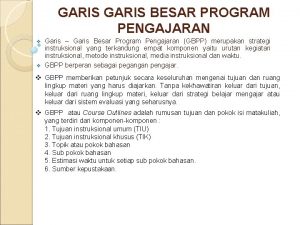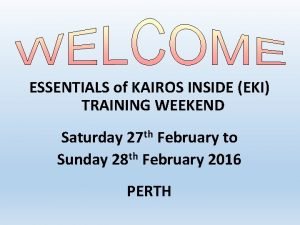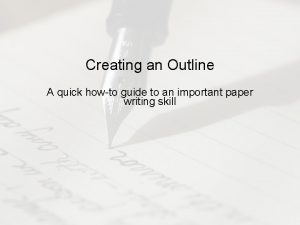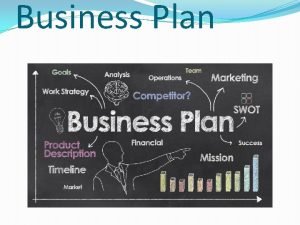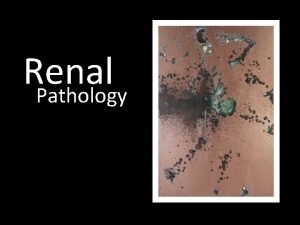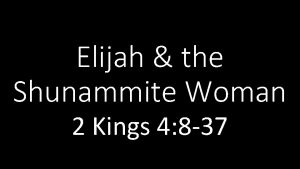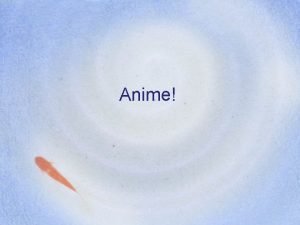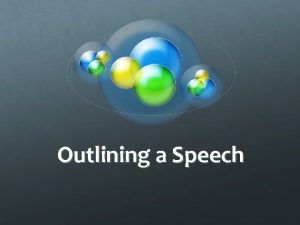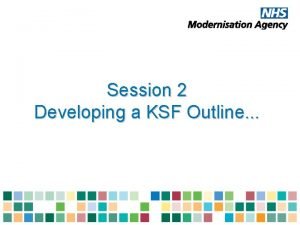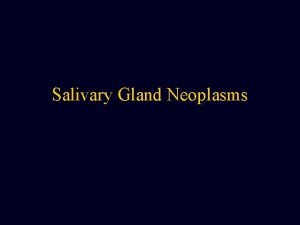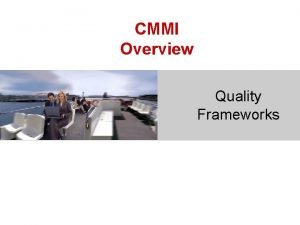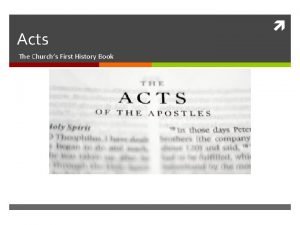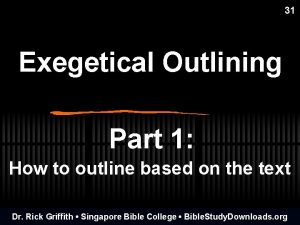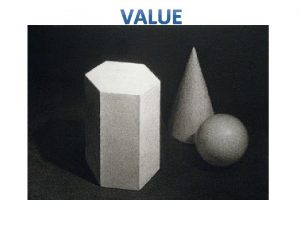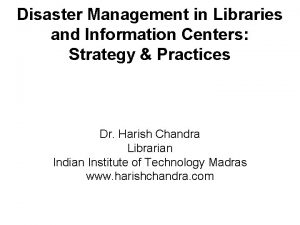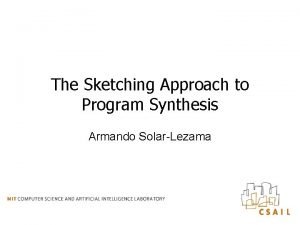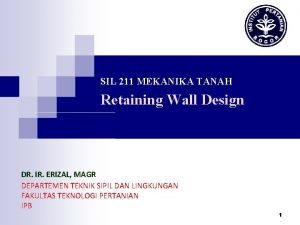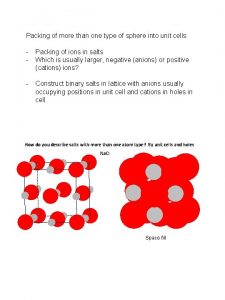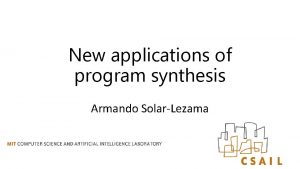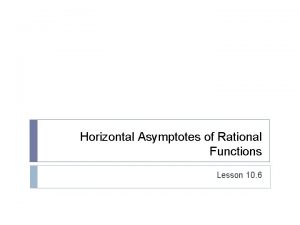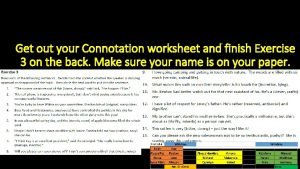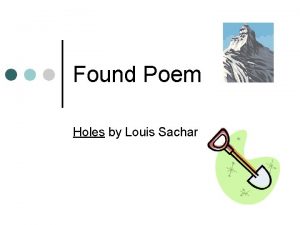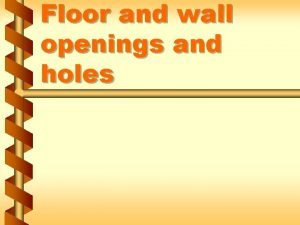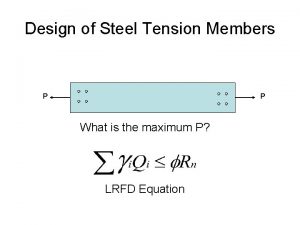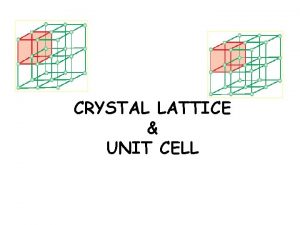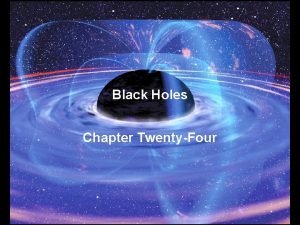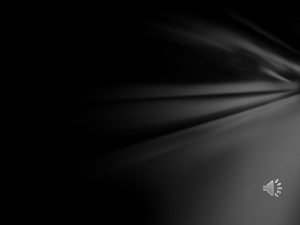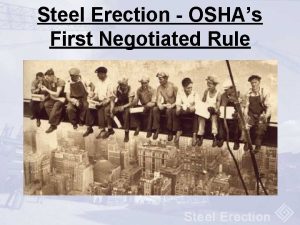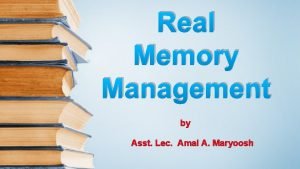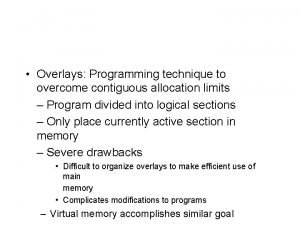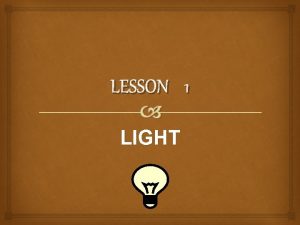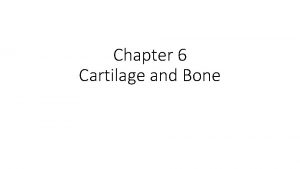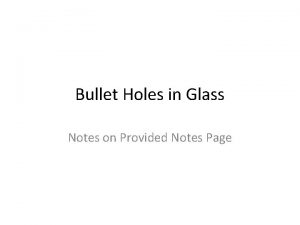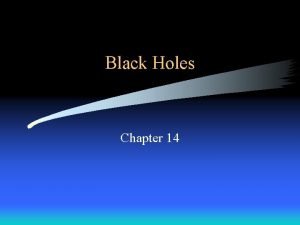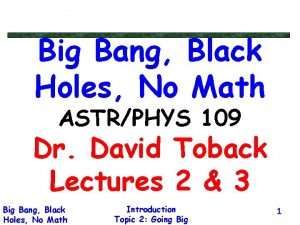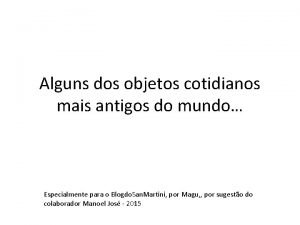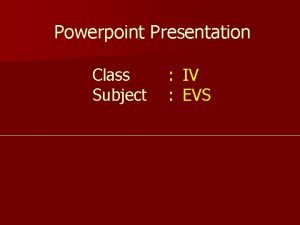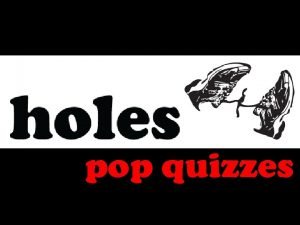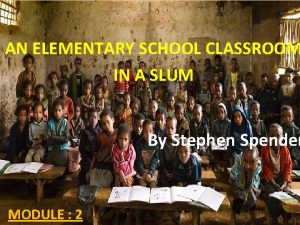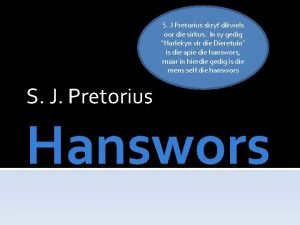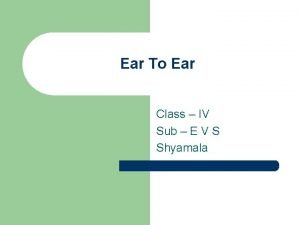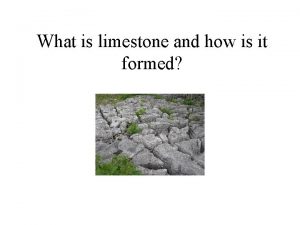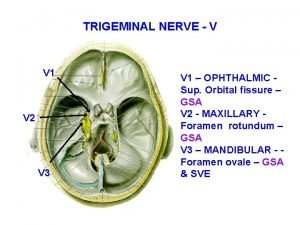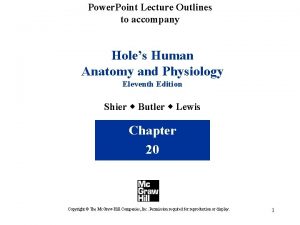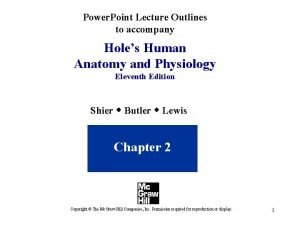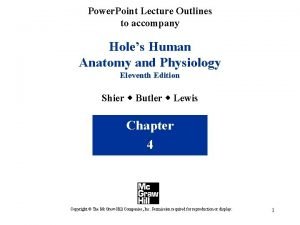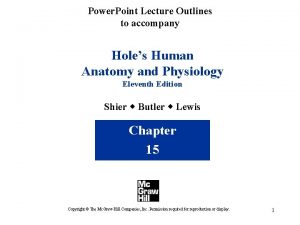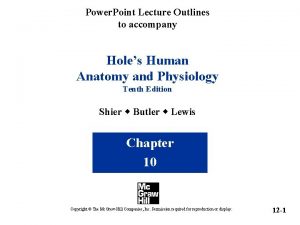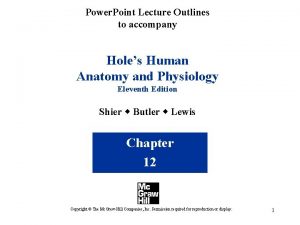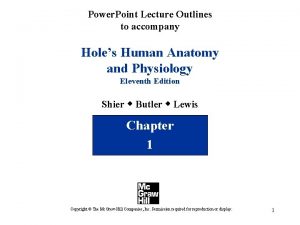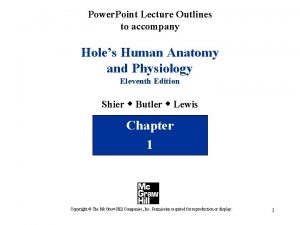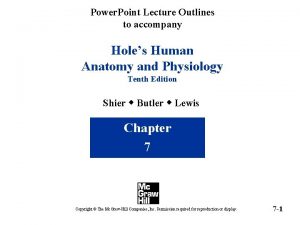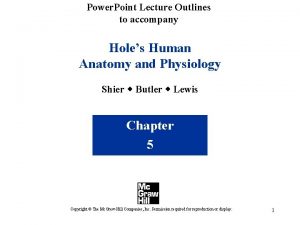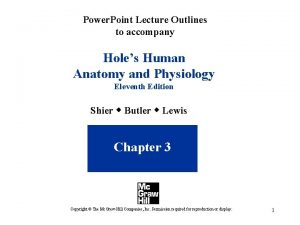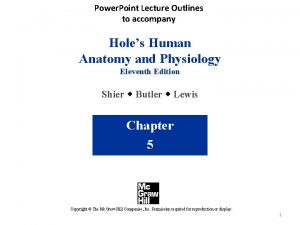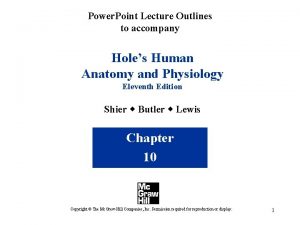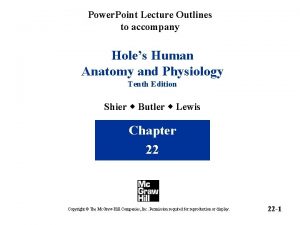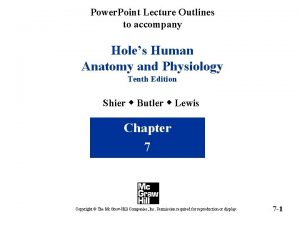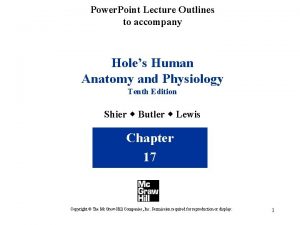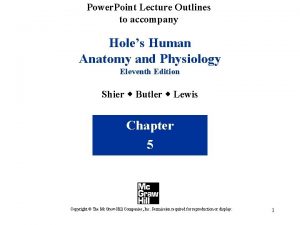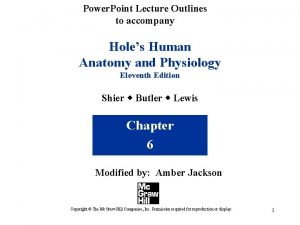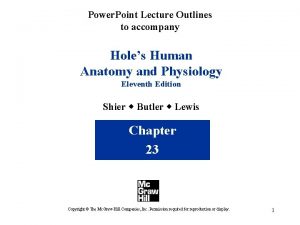Power Point Lecture Outlines to accompany Holes Human








































































- Slides: 72

Power. Point Lecture Outlines to accompany Hole’s Human Anatomy and Physiology Eleventh Edition Shier w Butler w Lewis Chapter 9 Copyright © The Mc. Graw-Hill Companies, Inc. Permission required for reproduction or display. 1

2 Functions of Muscular System • • Movement Posture Maintenance Joint Stability Heat Generation

3 Three Types of Muscle Tissue Skeletal Muscle Cardiac Muscle • usually attached to bones • under conscious control • striated • wall of heart • not under conscious control • striated Smooth Muscle • walls of most viscera, blood vessels, skin • not under conscious control • not striated

4 Structure of a Skeletal Muscle Composed of: - skeletal muscle tissue - nervous tissue - blood - connective tissues • fascia • tendons • aponeuroses

5 Skeletal Muscle Structure • Muscle cells called muscle fibers wrapped in endomysium • Bundles of muscle fibers called fasicles wrapped in perimysium • Many fasicles make a muscle and are wrapped in epimysium

6 Skeletal Muscle Fiber Structure • Muscle fibers are long, thin cells made of myofibrils • Myofibrils composed of 2 types of cytoskeleton • Myosin – thick protein filaments • Actin – thin protein filaments

7 Skeletal Muscle Fibers • sarcolemma - cell membrane • sacroplasm – cell cytoplasm • sarcoplasmic reticulum – endoplasmic reticulum • transverse tubule - channel that is continuous with sarcolemma and extends into sarcoplasm

8 Sarcomere: Unit of contraction • I bands – light area = actin only • A bands – dark area = overlapping actin and myosin • Z lines – dividing line between individual sarcomeres

9 Special Features of Myofilaments Thick Filaments = Myosin • cross-bridges Thin Filaments = Actin • associated with troponin and tropomyosin

10 Neuromuscular Junction Site where an axon and muscle fiber meet • motor neuron • motor end plate • synapse • synaptic cleft • synaptic vesicles • neurotransmitters

11 Motor Unit • single motor neuron • all muscle fibers controlled by motor neuron https: //www. youtube. com/watch? v=BMT 4 Pt. XRCVA Sliding Filament Model video

12 Stimulus for Contraction • acetylcholine (ACh) • nerve impulse causes release of ACh from synaptic vesicles • ACh binds to ACh receptors on motor end plate • generates a muscle impulse

13 Excitation Contraction Coupling • muscle impulses cause sarcoplasmic reticulum to release calcium ions into cytosol • calcium binds to troponin to change its shape

14 Excitation Contraction Coupling • position of tropomyosin is altered • binding sites on actin are exposed • actin and myosin molecules bind

15 Sliding Filament Model of Muscle Contraction When cross-bridges pull on actin the sarcromeres shorten, thick and thin filaments slide past one another

16 Cross-bridge Cycling When myosin is pulling on the actin, ATP is broken down into ADP and phosphate.

17 Relaxation acetylcholinesterase – enzyme that rapidly decomposes acetylcholine remaining in the synapse As a result: • muscle impulse stops • stimulus to sarcolemma and muscle fiber membrane ceases • calcium moves back into sarcoplasmic reticulum • myosin and actin binding prevented • muscle fiber relaxes

18 Major Events of Muscle Contraction and Relaxation

19 Energy Sources for Contraction 1) Creatine phosphate 2) Cellular respiration • creatine phosphate – stores energy that quickly converts ADP to ATP

Oxygen Supply and Cellular Respiration • Anaerobic Phase • glycolysis • occurs in cytoplasm • produces little ATP • Aerobic Phase • citric acid cycle • electron transport chain • occurs in the mitochondria • produces most ATP • myoglobin stores extra oxygen 20

21 Oxygen Debt Oxygen debt – amount of oxygen needed by liver cells to use the accumulated lactic acid to produce glucose • oxygen not available • glycolysis continues • pyruvic acid • converted to lactic acid • liver converts lactic acid to glucose

22 Muscle Fatigue • inability to contract • commonly caused from • decreased blood flow • ion imbalances across the sarcolemma • accumulation of lactic acid • cramp – sustained, involuntary muscle contraction

23 Heat Production • by-product of cellular respiration • muscle cells are major source of body heat • blood transports heat throughout body

24 Muscular Responses Threshold Stimulus • minimal strength required to cause contraction Recording a Muscle Contraction • twitch • latent period • period of contraction • period of relaxation • refractory period • all-or-none response

25 Summation • process by which individual twitches combine • produces sustained contractions • can lead to tetanic contractions

26 Recruitment of Motor Units • recruitment - increase in the number of motor units activated • whole muscle composed of many motor units • more precise movements are produced with fewer muscle fibers within a motor unit • as intensity of stimulation increases, recruitment of motor units continues until all motor units are activated

27 Sustained Contractions • smaller motor units (smaller diameter axons) - recruited first • larger motor units (larger diameter axons) - recruited later • produce smooth movements • muscle tone – continuous state of partial contraction

28 Types of Contractions • isotonic – muscle contracts and changes length • isometric – muscle contracts but does not change length

29 Fast and Slow Twitch Muscle Fibers Slow-twitch fibers (type I) • always oxidative • resistant to fatigue • red fibers • most myoglobin • good blood supply • many mitochodria • “dark meat” Fast-twitch glycolytic fibers (type IIa) • white fibers (less myoglobin) • poorer blood supply • susceptible to fatigue • “white meat” Fast-twitch fatigue-resistant fibers (type IIb) • intermediate fibers • oxidative • intermediate amount of myoglobin • pink to red in color • resistant to fatigue

30 Smooth Muscle Fibers Compared to skeletal muscle fibers • shorter • single, centrally located nucleus • elongated with tapering ends • myofilaments randomly organized • lack striations • lack transverse tubules • sarcoplasmic reticula not well developed • 2 types • Visceral – walls of hollow organs • Multiunit – iris of eye & blood vessesels

31 Smooth Muscle Contraction • Resembles skeletal muscle contraction • interaction between actin and myosin • both use calcium and ATP • both are triggered by membrane impulses • Different from skeletal muscle contraction • smooth muscle lacks troponin (replaced with calmodulin) • two neurotransmitters (acetlycholine and norepinephrine) affect smooth muscle • hormones affect smooth muscle • stretching can trigger smooth muscle contraction • smooth muscle slower to contract and relax • smooth muscle more resistant to fatigue

32 Cardiac Muscle • located only in the heart • muscle fibers joined together by intercalated discs • fibers branch • network of fibers contracts as a unit • self-exciting and rhythmic • longer refractory period than skeletal muscle

33 Characteristics of Muscle Tissue

34 Skeletal Muscle Actions • origin – immovable end • insertion – movable end • prime mover (agonist) – primarily responsible for movement • synergists – assist prime mover • antagonist – resist prime mover’s action and cause movement in the opposite direction

35 Body Movement Four Basic Components of Lever 1. rigid bar – bones 2. fulcrum – point on which bar moves; joint 3. object - moved against resistance; weight 4. force – supplies energy for movement; muscles

36 Levers and Movement

37 Life-Span Changes • myoglobin, ATP, and creatine phosphate decline • by age 80, half of muscle mass has atrophied • adipose cells and connective tissues replace muscle tissue • exercise helps to maintain muscle mass and function

38 Clinical Application Myasthenia Gravis • autoimmune disorder • receptors for ACh on muscle cells are attacked • weak and easily fatigued muscles result • difficulty swallowing and chewing • ventilator needed if respiratory muscles are affected • treatments include • drugs that boost ACh • removing thymus gland • immunosuppressant drugs • antibodies

39 More Clinical Applications • Moebius Syndrome • “walking corpse syndrome” or “stone face” • Tendinitis • Muscular Dystrophy • Poliomyelitis • Tetanus and Botulism • Lou Gehrig's disease • amyotrophic lateral sclerosis (ALS)

40 Major Skeletal Muscles

41 Major Skeletal Muscles

42 Muscles of Facial Expression

43 Muscles of Mastication

44 Muscles of Facial Expression and Mastication

45 Muscles That Move the Head and Vertebral Column

46 Muscles That Move the Head and Vertebral Column

47 Muscles That Move the Pectoral Girdle

48 Muscles That Move the Pectoral Girdle

49 Muscles That Move the Arm

50 Muscles That Move the Arm

51 Muscles That Move the Arm

52 Muscles That Move the Forearm

53 Muscles That Move the Forearm

54 Muscles That Move the Forearm

55 Cross Section of the Forearm

56 Muscles That Move the Hand

57 Muscles That Move the Hand

58 Muscles of the Abdominal Wall

59 Muscles of the Abdominal Wall

60 Muscles of the Pelvic Outlet

61 Muscles of Pelvic Outlet

62 Muscles That Move the Thigh

63 Muscles That Move the Thigh

64 Muscles That Move the Thigh

65 Muscles That Move the Leg

66 Muscles That Move the Leg

67 Muscles That Move the Leg

68 Muscles That Move the Leg

69 Muscles That Move the Foot

70 Muscles That Move the Foot

71 Muscles That Move the Foot

72 Cross-bridge Cycling • myosin cross-bridge attaches to actin binding site • myosin cross-bridge pulls thin filament • ADP and phosphate released from myosin • new ATP binds to myosin • linkage between actin and myosin cross-bridge break • ATP splits • myosin cross-bridge goes back to original position
 Things that accompany salvation
Things that accompany salvation Accompany chapter 1
Accompany chapter 1 Lymphatics that accompany the cephalic vein drain into the
Lymphatics that accompany the cephalic vein drain into the Inkjet printers are considered legacy technology
Inkjet printers are considered legacy technology Holes essential of human anatomy and physiology
Holes essential of human anatomy and physiology 01:640:244 lecture notes - lecture 15: plat, idah, farad
01:640:244 lecture notes - lecture 15: plat, idah, farad Power triangle
Power triangle Informsu
Informsu Point point power
Point point power What is an outlining
What is an outlining Outline learning objectives
Outline learning objectives Kairos program manual
Kairos program manual Foley v classique coaches
Foley v classique coaches Four main components for effective outlines
Four main components for effective outlines A business plan is a document that outlines
A business plan is a document that outlines Pyelonephritis
Pyelonephritis 2 kings 4 8 17 sermon
2 kings 4 8 17 sermon The history of anime
The history of anime Two types of outlines
Two types of outlines A haunted house virginia woolf analysis
A haunted house virginia woolf analysis Ksf outlines
Ksf outlines Mucoepidermoid carcinoma pathology outlines
Mucoepidermoid carcinoma pathology outlines High level outline
High level outline Acts outline
Acts outline Exegetical outline example
Exegetical outline example Cjis level 4 certification
Cjis level 4 certification Mun position paper outline
Mun position paper outline Visible outlines
Visible outlines Crohn's disease
Crohn's disease A clear concise document which outlines preventive
A clear concise document which outlines preventive Power system dynamics and stability lecture notes
Power system dynamics and stability lecture notes Power system analysis lecture notes
Power system analysis lecture notes Power semiconductor devices lecture notes
Power semiconductor devices lecture notes Switch mode power supply lecture notes
Switch mode power supply lecture notes Power system dynamics and stability lecture notes
Power system dynamics and stability lecture notes Human resource management lecture chapter 1
Human resource management lecture chapter 1 Human resource management chapter 1
Human resource management chapter 1 Human resource management lecture chapter 1
Human resource management lecture chapter 1 Things fall apart customs
Things fall apart customs Armando solar-lezama sketch c like language with holes
Armando solar-lezama sketch c like language with holes Mekanika tanah
Mekanika tanah How many octahedral holes in fcc
How many octahedral holes in fcc Armando solar-lezama sketch c like language with holes
Armando solar-lezama sketch c like language with holes I said
I said Rational functions holes and asymptotes
Rational functions holes and asymptotes Holes themes worksheet
Holes themes worksheet Holes poem
Holes poem Osha holes in floor
Osha holes in floor Gross section yielding
Gross section yielding Close packing
Close packing Structure of a black hole
Structure of a black hole 1984 chapter questions
1984 chapter questions Columns must be equipped with vertical stabilizer plates
Columns must be equipped with vertical stabilizer plates Coalescing holes in operating system
Coalescing holes in operating system Coalescing and compaction in os
Coalescing and compaction in os Formation of images through narrow holes
Formation of images through narrow holes Chondrocytes sits in holes called
Chondrocytes sits in holes called Carpentry tools and their classification
Carpentry tools and their classification Bullet exit holes
Bullet exit holes Chapter 14 holes
Chapter 14 holes Big bang, black holes, no math pdf
Big bang, black holes, no math pdf Venus holes
Venus holes Pictures of animals whose ears can be seen
Pictures of animals whose ears can be seen Quizzes
Quizzes Autocad countersink symbol
Autocad countersink symbol Holes anatomy and physiology chapter 1
Holes anatomy and physiology chapter 1 Figure of speech in far far from gusty waves
Figure of speech in far far from gusty waves Elementary classroom in a slum poetic devices
Elementary classroom in a slum poetic devices Sirkus gedigte
Sirkus gedigte Which animal ears cannot be seen?
Which animal ears cannot be seen? Die hanswors
Die hanswors Karst landscape diagram
Karst landscape diagram Mandibular foramen
Mandibular foramen










